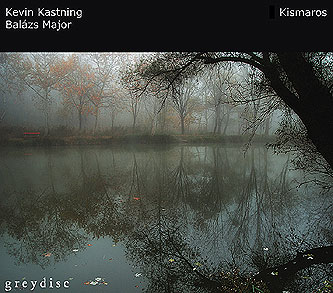 In
2018, New England guitar conceptualist and Greydisc label founder,
Kevin Kastning traveled to Hungary for his first solo tour
in Europe. Kastning’s affiliation with Hungarian musician and
guitarist / composer Sándor Szabó is world renowned,
as the duo have recorded several albums together, including two albums
with fellow Hungarian composer and percussionist Balázs
Major. For the 2018 CD release of Kismaros, Kastning
joins forces with Balázs for their first duo record together,
and the results provide one of the best album releases yet on the
Greydisc label. What started out as one track featuring Kevin and
Balázs, turned into a complete album thanks in part to Kismaros
producer Sándor Szabó, who astutely captured the
duo and encouraged them to keep recording after the first track was
completed. Such sonic spontaneity is rare but not uncommon in the
freeform improvisational world of first class musicians such as Kastning
and Major. In his commentary on Kevin Kastning’s web site, Sándor
Szabó
compares
the Kismaros sessions to music that guitarist Egberto Gismonti
and percussionist Nana Vasconcelos played during their 1980’s
tour of Hungary. That heightened sense of guitar extrapolations mixing
with magical percussion can be heard and appreciated on Kismaros.
Commenting on the Kismaros sessions, producer Sándor
once again recalls, “What I heard on the album is again what
I heard that morning: original, exotic, exciting, seducing, spiritual
music. For me this is a new music; another reference which proves
that there are still endless possibilities in a guitar/percussion
duo to explore. I am very glad to be part of this kind of creation."
The intriguing Kismaros album cover art perfectly captures
the ethereal and magical sense of the music on the CD. Fans of Kasting’s
more recent albums—as well as the 2013 CD release of Becoming,
featuring Kevin recording with Balázs and Sándor—will
note that the entire album was played by Kastning’s famous 30-string
Contra-Alto guitar and the myriad of percussion instruments played
by Balázs. A creative and visceral listening experience, Kismaros
is improvisational guitar / percussion music at its finest. www.kevinkastning.com
/ www.balazsmajor.com
In
2018, New England guitar conceptualist and Greydisc label founder,
Kevin Kastning traveled to Hungary for his first solo tour
in Europe. Kastning’s affiliation with Hungarian musician and
guitarist / composer Sándor Szabó is world renowned,
as the duo have recorded several albums together, including two albums
with fellow Hungarian composer and percussionist Balázs
Major. For the 2018 CD release of Kismaros, Kastning
joins forces with Balázs for their first duo record together,
and the results provide one of the best album releases yet on the
Greydisc label. What started out as one track featuring Kevin and
Balázs, turned into a complete album thanks in part to Kismaros
producer Sándor Szabó, who astutely captured the
duo and encouraged them to keep recording after the first track was
completed. Such sonic spontaneity is rare but not uncommon in the
freeform improvisational world of first class musicians such as Kastning
and Major. In his commentary on Kevin Kastning’s web site, Sándor
Szabó
compares
the Kismaros sessions to music that guitarist Egberto Gismonti
and percussionist Nana Vasconcelos played during their 1980’s
tour of Hungary. That heightened sense of guitar extrapolations mixing
with magical percussion can be heard and appreciated on Kismaros.
Commenting on the Kismaros sessions, producer Sándor
once again recalls, “What I heard on the album is again what
I heard that morning: original, exotic, exciting, seducing, spiritual
music. For me this is a new music; another reference which proves
that there are still endless possibilities in a guitar/percussion
duo to explore. I am very glad to be part of this kind of creation."
The intriguing Kismaros album cover art perfectly captures
the ethereal and magical sense of the music on the CD. Fans of Kasting’s
more recent albums—as well as the 2013 CD release of Becoming,
featuring Kevin recording with Balázs and Sándor—will
note that the entire album was played by Kastning’s famous 30-string
Contra-Alto guitar and the myriad of percussion instruments played
by Balázs. A creative and visceral listening experience, Kismaros
is improvisational guitar / percussion music at its finest. www.kevinkastning.com
/ www.balazsmajor.com
mwe3.com presents an interview with
Kevin Kastning and Balázs Major
The Kismaros Interview
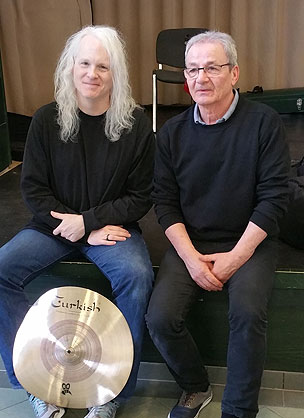 mwe3:
You always have such interesting titles for your albums. On reflection,
what was it about the Hungarian town of Kismaros that inspired the
Kismaros album and can you shed some light on your recent 2018
European tour and how many shows and what material was performed live
on that tour? What was the reaction this time from those attending
the shows? I imagine Kevin must be something of a unique attraction
in Hungary, an American musician coming from the Boston area with
those exotic guitars.
mwe3:
You always have such interesting titles for your albums. On reflection,
what was it about the Hungarian town of Kismaros that inspired the
Kismaros album and can you shed some light on your recent 2018
European tour and how many shows and what material was performed live
on that tour? What was the reaction this time from those attending
the shows? I imagine Kevin must be something of a unique attraction
in Hungary, an American musician coming from the Boston area with
those exotic guitars.
Kevin Kastning: Kismaros is a small village located on the
banks of the Danube river in Hungary. It's very peaceful, and has
a palpable sense of history and the presence of those who have passed
on. Because the album was recorded in the Kismaros concert hall, I
wanted to assign an album title that would also serve as a location
on a map, to illustrate the recording location. And also to pay tribute
to the town and its people. I wanted to try to allude to some sense
of the overall atmosphere of mystery and time that I felt in Kismaros.
The tour had a concert in Kismaros, and the mayor came to the concert
and caught up to me afterwards. He is a big fan it turns out, and
was very welcoming. I felt like a very welcome guest in Kismaros,
and that added to using the town name as the album title.
For the 2018 tour, I used the 30-string Contra-Alto guitar. It was
a solo tour, but I played one duet piece each night with Sándor
Szabo, which was wonderful. The concerts were sold-out, and the audiences
were very receptive and appreciative.
Balázs Major: We had a very successful concert in Kismaros,
and then we had a two-day recording session. This small town is situated
in the Danube curve and has a strong natural vibe. Driving to the
recording spot the traveler can see a lot of beauty, which inspires
not only a musician, but also it makes one wonder and contemplate.
So, Sándor probably chose this place to record not by accident.
That place made an influence also on me and on my playing. Listening
back to the recording, it recalls those moods and visual wonders.
mwe3: What was Kevin’s overall impression of Hungary on
this tour and what other lasting memories do you have of performing
and recording there and traveling in the country this time? How was
the climate or weather like in Hungary in mid May?
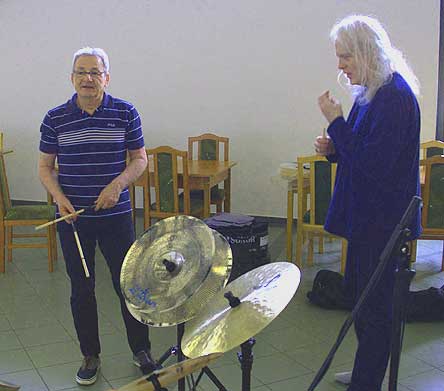 Kevin
Kastning: I always love being in Hungary and touring there. Everyone
is incredibly warm and welcoming. The Hungarians are a fantastic people;
very sweet. The weather was like late spring; in the upper 70s/low
80s.
Kevin
Kastning: I always love being in Hungary and touring there. Everyone
is incredibly warm and welcoming. The Hungarians are a fantastic people;
very sweet. The weather was like late spring; in the upper 70s/low
80s.
mwe3: What were some of the challenges involved in recording
with only one guitar, in this case, the 30 string Contra-Alto guitar
on the Kismaros album? How did the 30-string guitar shape the
final sound of the album and were there challenges in traveling on
a long journey with that guitar?
Kevin Kastning: This is the first time I've tracked a full
album using only one instrument. It is a big challenge. Using the
30-string was the right choice; it has the Alto side, the Contraguitar
side, and both sides have fretless regions. I used the 30 for the
tour, and it is one of my very favorite instruments ever. As for how
it shaped the final sound of the album, it was half of the instruments
you hear on the record, so that is a pretty big impact. For the air
travel part of the tour, I bought a seat on the plane for the guitar.
So it was never checked through baggage, and it and I both had a safe
trip.
Balázs Major: It is always a challenge to me to play
together with never-heard instruments. Kevin’s guitars are real
magic instruments, though I knew their voice from his CDs, but in
a live situation they effect in a different way. His 30-string guitar
with his playing inspired me very strongly.
mwe3: On the web, Balázs spoke about recording
an album with Kevin, Roland Heidrich and Sándor Szabó.
What was the chemistry like between the four of you? I ask this considering
that Roland engineered Kismaros and Sándor produced
the album. Was any other recording done in Hungary this time and are
there any other plans to record with Sándor and Balázs
as well as Roland again in the future?
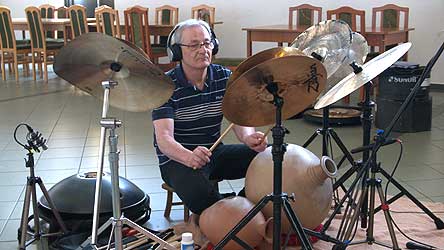 Kevin
Kastning: We tracked new material for two albums as a trio consisting
of Balázs, Sándor, and me. We tracked new material for
a quartet album with Roland. Both Sándor and Roland were using
electric guitars, but in very different ways. The quartet recordings
were very full, like a band. The trio recordings are very different
than our two previous trio records in that Sándor was using
electric guitars and heavy processing and effects, along with guzheng.
So these albums will be released over the coming years. The chemistry
was quite good all around. I have a spiritual connection with both
Sándor and Balázs. Whenever I am playing with either
of them, the music takes over; it is as if we all have this almost
psychic connection or system of unspoken communication. Roland is
a strong and original musician whom I’ve known for several years,
so it was good to work with him as well.
Kevin
Kastning: We tracked new material for two albums as a trio consisting
of Balázs, Sándor, and me. We tracked new material for
a quartet album with Roland. Both Sándor and Roland were using
electric guitars, but in very different ways. The quartet recordings
were very full, like a band. The trio recordings are very different
than our two previous trio records in that Sándor was using
electric guitars and heavy processing and effects, along with guzheng.
So these albums will be released over the coming years. The chemistry
was quite good all around. I have a spiritual connection with both
Sándor and Balázs. Whenever I am playing with either
of them, the music takes over; it is as if we all have this almost
psychic connection or system of unspoken communication. Roland is
a strong and original musician whom I’ve known for several years,
so it was good to work with him as well.
Balázs Major: Sándor is a determinative artist
in my life, we are tied-in by an almost 41-year friendship and creation
in duo and different formations. We played countless concerts and
made a lot of recordings, albums together. Roland is an excellent
young guitar player Sándor’s ex –student, we have
also a 10-year long friendship and musical collaboration in trios,
and in his new quartet. Kevin also belongs to my best friends; we
played and recorded a lot, so we have a strong chemistry when playing.
I would say it is very easy to play with these guys. We see the world
very similarly and our attitude for the music is the same.
We made two Greydisc albums with Kevin and Sándor: Triptych
and Becoming. Last year we started to work in a special “remote”
way; I recorded drum tracks and later Kevin and Sándor played
overdubs on them, and this recording will be Ethereal II, which
will be released in the early autumn of 2018. This album is special
to me because I play not only hand percussion, but also a full drum
set. Though my name mostly appears in formations where I play hand
percussion, I am a jazz drummer.
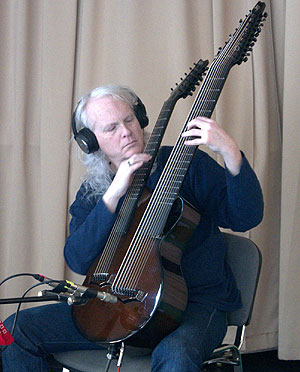 mwe3:
Balázs describes Kismaros as being enigmatic and nature-related.
In what ways would you say the Kismaros album has a nature-related
sensibilities and would you say the CD cover art backs up those themes?
What can you tell us about the CD cover art by László
Hutton and also the interesting looking photo on the inside of the
album?
mwe3:
Balázs describes Kismaros as being enigmatic and nature-related.
In what ways would you say the Kismaros album has a nature-related
sensibilities and would you say the CD cover art backs up those themes?
What can you tell us about the CD cover art by László
Hutton and also the interesting looking photo on the inside of the
album?
Kevin Kastning: Speaking for myself, I’d say all of my
records are nature-related, as I find nature to be a strong source
of renewal and of art. Kismaros is no exception. The cover
art is by László Hutton, a Hungarian photographic artist.
László has done a few of my previous album covers; I
admire his work. For Kismaros, I wanted something for the cover
that had an essence of Hungary. I had recorded this album with Balázs,
a Hungarian artist, and the album was recorded in Hungary. I wanted
Hungarian art on the cover to show proper tribute and how indebted
I felt to the Hungarian people, as well as to illustrate the connection
of the music to Hungary itself. The photo is of a nature preserve
in Hungary that I visited on my first tour there several years ago.
The atmosphere of the photo fits with the mysterious nature of the
pieces on the record.
I did the photo in the gatefold. Those are totems in Kismaros, right
on the banks of the Danube river. I’d pass them every day on
the way to the concert hall, and they seemed to have a palpable presence
to them. Very historic, and they had the sense of being sentries,
sentinels, and keepers of the past. They exuded such a strong presence
that I wanted them to be a part of the Kismaros album, as they
were and are a part of the village of Kismaros.
Balázs Major: About the pictures taken by László
Hutton it is not much to say just enough to look at it and my imagination
starts, it is like as if I would live in them, the misty spots are
the mystery themselves, there are a lot of secrets behind them, just
like in the music.
mwe3: The sheer amount of percussion instruments Balázs
plays on Kismaros is quite impressive. What were some of percussion
instruments that were played on Kismaros especially as they
look rather intriguing including the bowl shaped instruments. Did
Balázs use the full range of his instruments on the new album?
Did some tracks require different percussion instrumentation?
Kevin Kastning: I think Balázs was changing cymbals
for each piece, which is great. I love cymbals, and he has some beautiful
ones, as you can hear on the record.
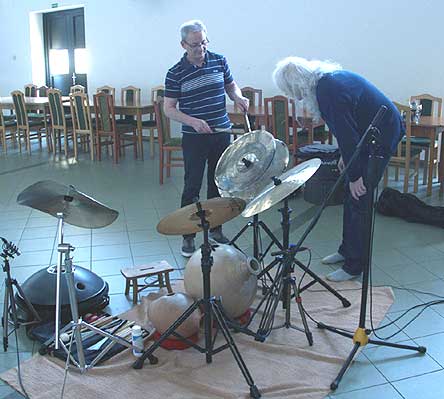 Balázs
Major: The special hand-percussion I use are a sort of clay drums.
They have a few thousand of years of history. They originate from
Nigeria and their actual name is UDU. In my percussion set they become
even more special because they are combined with several different
sounding cymbals, and they together create a very special set which
is not typical in the modern music. They provide a completely different
approach and sound in rhythm. I use a lot of cymbals, but somehow
I use those types of cymbals, which are not preferred by other players,
so my whole set is like something from another planet. They fit perfectly
to Kevin’s music and sound. I like experimenting with them and
I often make my own drum sticks. I like to use unusual combinations.
I use maybe 50-60 different sticks which I change during playing and
this is why the sound is very rich and changing all the time. I did
not use all my percussion on the recording only the most special and
extreme sounding ones.
Balázs
Major: The special hand-percussion I use are a sort of clay drums.
They have a few thousand of years of history. They originate from
Nigeria and their actual name is UDU. In my percussion set they become
even more special because they are combined with several different
sounding cymbals, and they together create a very special set which
is not typical in the modern music. They provide a completely different
approach and sound in rhythm. I use a lot of cymbals, but somehow
I use those types of cymbals, which are not preferred by other players,
so my whole set is like something from another planet. They fit perfectly
to Kevin’s music and sound. I like experimenting with them and
I often make my own drum sticks. I like to use unusual combinations.
I use maybe 50-60 different sticks which I change during playing and
this is why the sound is very rich and changing all the time. I did
not use all my percussion on the recording only the most special and
extreme sounding ones.
mwe3: What was involved in mic-ing the instruments during the
Kismaros recording session? Did microphone placement affect
the sound of the album sound and how did you balance the low frequencies
of the percussion with the guitar sounds? I noticed some unusually
low or sub frequencies on this album... Was a special balance of sound
created to capture everything with the microphones, so not to get
too high or too low a frequency in the recorded sound?
Kevin Kastning: The 30-string has some very low sub-bass frequencies;
its range goes lower than a bass, so it can create some recording
challenges. My recording setup for Kismaros was different than
my usual studio setup. For the Kismaros recordings, I used
my K&K stereo pickup system, along with a matched stereo pair
of Shure KSM-141 microphones. Sándor did all the mixing and
mastering, so the balance to which you refer was accomplished by Sándor
in the mixing phase. Roland Heidrich was the recording engineer for
the sessions, and he did a truly remarkable job on everything.
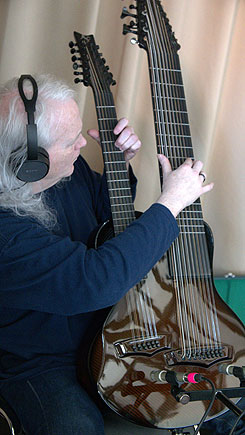 Balázs
Major: When I record drums or percussion, Roland or Sándor
is my sound engineer. They both have a great assortment of microphones.
This time we used Sándor’s DPA 4011 matched pair for percussion.
Sándor has a simple but very effective concept for recording
which can be described in one sentence: “The less microphones,
the less problems and the cleanest sound.” I trust them because
I never heard myself in such a high quality as how Roland and Sándor
can capture the sound of my instruments. My udus have real sub-harmonic
range. When I got my larger udu, it was very unusual to hear that
extra deep range but after a while it became an indispensable element
of my sound.
Balázs
Major: When I record drums or percussion, Roland or Sándor
is my sound engineer. They both have a great assortment of microphones.
This time we used Sándor’s DPA 4011 matched pair for percussion.
Sándor has a simple but very effective concept for recording
which can be described in one sentence: “The less microphones,
the less problems and the cleanest sound.” I trust them because
I never heard myself in such a high quality as how Roland and Sándor
can capture the sound of my instruments. My udus have real sub-harmonic
range. When I got my larger udu, it was very unusual to hear that
extra deep range but after a while it became an indispensable element
of my sound.
A regular sound engineer would cut this range, but we keep it. Our
music is sparse and has space for everything. Our recordings have
been utilized for testing the frequency range of HIFI systems. I used
extra high range cymbals, but Sándor found a way how to capture
all my set with only a stereo pair of microphone without EQ or cutting
any ranges. We do not use EQ for the percussion. The EQ is actually
done by the microphone itself, and by the proper position, this is
why in the mixing process there is no extra EQ.
mwe3: Being that the album features tracks called “Kismaros
I” through “Kismaros VII”, how do the album pieces
vary and compare with each other. Were the tracks edited in some way
during the sessions or was the session recorded in one continuous
recording with editing and track selection done afterwards? Did the
producer give any instructions or feedback during the recording and
how much editing or sonic manipulation was done post-recording?
Kevin Kastning: The album was recorded in a single session
one morning. The pieces on the album are in the same order as they
were recorded. I asked Balázs early that morning if he’d
mind tracking a duo piece with me; he said sure, so we did. At the
conclusion of that piece, which is “Kismaros I” on the album,
Sándor insisted that we record an entire album right there,
right then. Which we did; the directions were determined by Balázs
and I.
Balázs Major: As much as I know Sándor, as a
producer and mixing engineer told me that he left everything in its
original state. Hi did not cut out parts, and also the sequence of
the songs were the same as how we played them. I could say it is an
almost untouched recording in this aspect. Sándor helped us
during the session and actually he encouraged us to record this duo
album. He was listening to the recording on his headphone during the
entire session and he had some ideas to me to change the combination
of cymbals, because I used some new ones which he did not hear before
and we experimented with them. Knowing Sándor’s acoustic
recording concept, he is very demanding in microphones and he always
spends enough time to choose the right acoustic place to record. He
uses sound manipulating devices, only if there is no other way to
make the proper sound. On the Kismaros album he used only a
high-end reverb for the entire mix.
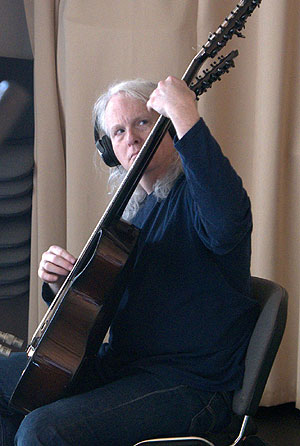 mwe3:
How do you compare Kismaros with the other albums on Greydisc
that also feature Kevin with both Sándor and Balázs?
What other Greydisc albums is Balázs playing on and was the
last time you all recorded together on the 2013 Becoming album?
Can you compare, perhaps offer a sonic reflection, of Kismaros
with Becoming? What other albums has Balázs recorded
on or released over the past few years?
mwe3:
How do you compare Kismaros with the other albums on Greydisc
that also feature Kevin with both Sándor and Balázs?
What other Greydisc albums is Balázs playing on and was the
last time you all recorded together on the 2013 Becoming album?
Can you compare, perhaps offer a sonic reflection, of Kismaros
with Becoming? What other albums has Balázs recorded
on or released over the past few years?
Kevin Kastning: Kismaros is quite different to the extent
that it doesn’t compare to our previous trio records. We do have
a new trio record being released later this year entitled Ethereal
II. This is the second entry in the new Ethereal series.
While it is still a trio record, it too is so different from the previous
trio records that a comparison is not possible.
Balázs Major: Each album is different, it is not worth
to compare them because they were made in different periods of our
artist life in different circumstances and instruments. As for myself
in the last few years I recorded with Michael Manring, Ralf Gauck,
Claus Boesser Ferrari, Alf Wilhelm Lundberg with Sándor as
a constant partner. Some recordings were live concerts and some overdubs
in studio.
The Asymmetry album is an overdub creation. Sándor experimented
with Michael Manring’s prerecorded tracks. He overdubbed on them.
Later he showed me the result and asked me to play some overdubbed
percussion. That is a very special album, but it was not economical
to print real CDs, so Asymmetry is only a digital download
album released by Greydisc. That is a pity that online magazines do
not review digital albums. We started to work on the Ethereal
series which is a long-term project and as such it is challenging
to me as a percussion player because this series has a special concept
to show that “there is life behind the grooves”.
You can imagine as a percussion player I am not against the grooves,
but it is really very obvious that the music world is going to a uniformed
“groovy” direction. The Ethereal series is a kind
of fresh oasis with its sparseness and soulfulness to show beauty
in the music which in other situations could have been obscured by
the dense and loud grooves.
mwe3: What other plans do you have for 2018 as far as new Greydisc
releases, upcoming recording and live performing in the near future?
Kevin Kastning: Upcoming Greydisc releases are Ethereal
II, the new trio recording with Sándor and Balázs.
My next solo record is in the can, and will be released in late 2018.
In 2019, there are about a  half-dozen
albums slated for release; most of those are already in the can. I
am in the studio with Mark Wingfield in August this year for our next
one, and then in September I am in the studio with Carl Clements for
our new one. I have a concert or two with Carl later in 2018, and
Wingfield and I are doing a live radio performance for WNYC in New
York City on August 13th, 2018. I also have an upcoming recording
project with Estonian composer/guitarist Robert Jurjendal, and I’m
looking forward to that.
half-dozen
albums slated for release; most of those are already in the can. I
am in the studio with Mark Wingfield in August this year for our next
one, and then in September I am in the studio with Carl Clements for
our new one. I have a concert or two with Carl later in 2018, and
Wingfield and I are doing a live radio performance for WNYC in New
York City on August 13th, 2018. I also have an upcoming recording
project with Estonian composer/guitarist Robert Jurjendal, and I’m
looking forward to that.
Balázs Major: In 2018 I will have quite a lot concerts
with a band called BOGA and we planned some overdub recordings with
Sándor for further Echolocation and Ethereal projects.



